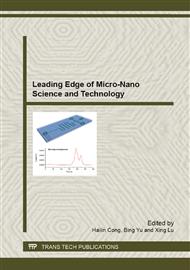p.51
p.55
p.63
p.67
p.72
p.79
p.85
p.91
p.95
Electrochemical Deposition and Properties Research of ZnO Thin Films
Abstract:
The transparent ZnO films were deposited on the indium tin oxide (ITO) coated glass substrates by using the square wave potential deposition method. The conductive graphite plate is used for counter electrode, electrolyte consist of zinc nitrate and additive of electrochemistry, which is made up CTAB and potassium nitrate. Crystallinities of the films were examined by X-ray diffractometer. The morphologies of zinc oxide films were observed with atomic force microscope. Optical characteristics of zinc oxide layers were measured with UV–vis spectrophotometer. The optimal conditions for preparation of zinc oxide thin films with the square wave potential method were as follows: the deposition time was 6 min, concentration of zinc nitrate was 0.05mol/L, deposition temperature was 80 °C, and the annealing temperature was 500 º C. The average optical transmittance of the ZnO films is higher than 85% in the visible range. Moreover, the films have flat surface and small grain size.
Info:
Periodical:
Pages:
72-78
Citation:
Online since:
March 2013
Authors:
Price:
Сopyright:
© 2013 Trans Tech Publications Ltd. All Rights Reserved
Share:
Citation:


